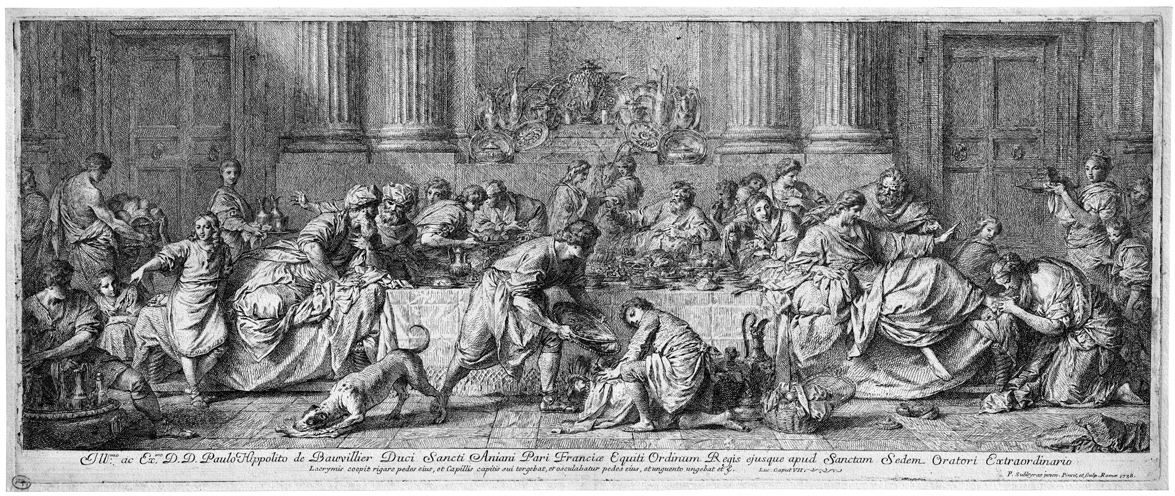Loading the page ...
Pierre Subleyras
(1699 Uzès – 1749 Rome)
Meal in the House of Simon. Etching. 24.6 x 60.8 cm. 1738. Robert-Dumesnil 3; exhibition catalogue Subleyras. 1699–1749, published by P. Rosenberg, O. Michel, Paris, Musée du Luxembourg, 1987, p. 200, II (of V).
This large, carefully and discriminatingly executed print is regarded as the artist’s principal work in this medium (‘sans nul doute le chef-d’oeuvre du maître’, Robert-Dumesnil). It is a reproduction of the painting Subleyras made in Rome in 1737 which was to finally establish his reputation as a painter. The enormous picture, which is almost seven metres wide, was designed for the refectory of the Santa Maria Nuova monastery in Asti and is now in the Musée du Louvre in Paris. The etching is of great rarity, particularly since it is an early impression. Authors of earlier generations, such as Portalis und Beraldi, already pointed to this fact (‘les pièces gravées par Subleyras sont d’une extrême rareté’, Les graveurs du dix-huitième siècle, vol. III, Paris 1882, p. 574).
The highly talented and much sought-after Pierre Subleyras was a died-in-the-wool painter, etching clearly being no more than a sideline for him. Trained by Antoine Rivalz in Toulouse, Subleyras did his apprenticeship at the Royal Academy in Paris and, having been awarded the prestigious Prix de Rome (1727), spent the rest of his life in Rome. There the artist was given great encouragement by Nicolas Vleughels, the Director of the Académie de France, and was soon one of the most famous and busiest painters in Rome. A member of the Accademia di S. Luca from 1740, Subleyras painted altar pieces, historical scenes and mythological subjects and also made a name for himself as a portraitist of the Roman aristocracy and clergy. Subleyras’ portraits, in particular, are distinguished by their stupendous painterly quality and their intensive, highly individual psychological characterisation. The present etching, which reproduces the painting in reverse, is likewise remarkable for its virtuoso craftsmanship and sophisticated style. The multi-figured, lavishly arranged composition shows the extent to which Subleyras was indebted to his predecessor Veronese. The charm of the picture stems from the great variety of accurately observed details and, with the individual protagonists interacting in a convincing and harmonious manner, the result is a delightful compositional continuum. It is hard to maintain visual concentration, as the eye darts back and forth through the host of lively and vivid motifs. The ceremony of the washing of the feet, the central theme of the scene, takes place on the extreme right-hand edge of the picture, as if swept to one side by the turbulence of the feast. The whole scene is treated in a detailed, sensitive etching technique which produces a delicately graduated, vibrating chiaroscuro effect.
Subleyras must have been a perfectionist par excellence not just as a painter, but also as an etcher. This is evidenced by the five different printing states which are distinguished by minor subtle changes, thereby illustrating the multi-facetted genesis of the etching. The first state, now in the National Gallery of Art in Washington, is in all probability unique. It is an impression avant la lettre and before the slight reworking of the figures on the left-hand edge of the picture. Our impression of the extremely rare second state of the etching is before the additional hatching on the floor and before the numerous other shifts of emphasis in the subsequent three states.
A superb, harmonious and contrasting impression from the still partly uncleaned plate; with margins around the inky platemark. The guiding lines for the inscription still clearly visible, with fine needle scratches in the white margins. Minor ageing, otherwise in perfect condition. From the collection of François Heugel (Lugt 3373).
